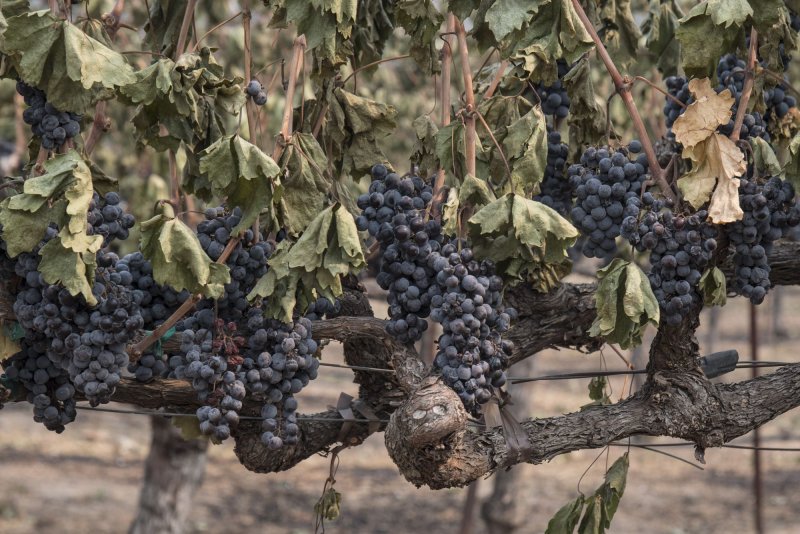
Rows and rows of Cabernet Franc grapes are ruined before harvest
by the Glass Fire on Davis Estates vineyard in Calistoga, Calif., in September 2020.
File Photo by Terry Schmitt/UPI | License Photo
Jan. 19 (UPI) -- Millennials are turning away from wine, a new report on the state of the industry finds, leaving industry executives on the hunt for a new way to market the beverage to younger consumers.
The 2022 State of the Wine Industry Report, issued Wednesday by Silicon Valley Bank, finds that people over 65 are the demographic by far most likely to choose wine over other options. Younger drinkers are increasingly drawn to competing alcoholic beverages -- beer, spirits, and spiked seltzers.
Baby boomers drink more wine than millennials by nearly a 2-to-1 ratio.
"Unless the industry does more to attract consumers younger than 65, wine consumption might drop by 20 percent when boomers sunset," states the 66-page report, which includes data and survey results from dozens of sources.
Jan. 19 (UPI) -- Millennials are turning away from wine, a new report on the state of the industry finds, leaving industry executives on the hunt for a new way to market the beverage to younger consumers.
The 2022 State of the Wine Industry Report, issued Wednesday by Silicon Valley Bank, finds that people over 65 are the demographic by far most likely to choose wine over other options. Younger drinkers are increasingly drawn to competing alcoholic beverages -- beer, spirits, and spiked seltzers.
Baby boomers drink more wine than millennials by nearly a 2-to-1 ratio.
"Unless the industry does more to attract consumers younger than 65, wine consumption might drop by 20 percent when boomers sunset," states the 66-page report, which includes data and survey results from dozens of sources.
The warning isn't new for an industry that's been sounding alarm bells about its aging consumer base for several years. But this report was more alarming because wine experts expected a strong rebound in 2021 as restaurants and bars reopened after pandemic closures.
Instead, wine lost market share to spirits.
"The reopening celebration that took place in 2021 didn't include the wine industry," the report states.
Worsening droughts and wildfires also impacted wine yields last year, the report found. Climate change put pressure on producers to find reliable water sources; meanwhile, surging property insurance costs coupled with supply and labor shortages drove "excessive markups," further deterring frugal young drinkers.
In one survey, 42% of producers indicated that they intend to raise their prices this year.
"The wine industry overcame numerous hurdles to achieve a hard-earned, solid year of sales. That said, looking at the long-term trends, this year reveals issues with both consumer demand and the ongoing climate crisis that may impact business conditions for the industry in the years to come," Rob McMillan, founder of Silicon Valley Bank's Wine Division and author of the report, said in a press release.
"The lesser interest in wine among younger consumers, coupled with the encroaching retirement and decreasing wine consumption of wine-loving baby boomers, poses a primary threat to the business."
But the report highlights some recommended strategies for appealing to younger customers. Unlike "status-seeking boomers" more likely to splurge on expensive wines, Millennials, "having lived through the Great Recession and a pandemic, aren't destined to be consumers who will show off their wealth."
To pivot to a younger generation, wine producers should highlight their social values when marketing their product, the report recommends -- staff diversity, health consciousness and sustainability are more important to millennial consumers.
"If we really want to reach the millennial, we need to move away from lifestyles of the rich and famous and add cause-based marketing to our outreach," the report states.
No comments:
Post a Comment